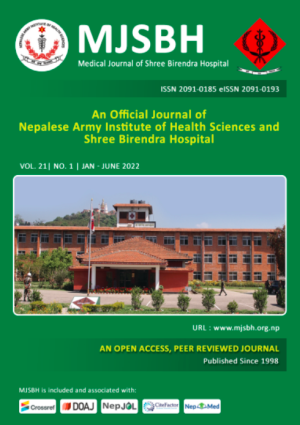Pattern of Thyroid Illness in a Tertiary Hospital in Nepal
Keywords:
Hyperthyroidism, Hypothyroidism, Nepal, Sub-Himalayan region, Thyroid Stimulating Hormone (TSH)Abstract
Introduction: Thyroid dysfunction is an important endocrine disorder worldwide among which hypothyroidism, is attributed to environmental deficiency of iodine. Congenital hypothyroidism is one of the most common preventable causes of intellectual disability worldwide. Hypothyroidism is easily treated and timely detection and treatment of the disorder could reduce the adverse fetal and maternal outcome. The aim of our study is to find the prevalence of thyroid illness in a tertiary health care center of Nepal.
Methods: This was a descriptive, cross-sectional study carried out in the Department of Biochemistry of Shree Birendra Hospital, Chhauni, Kathmandu over a period of five months from March 2021 to July 2021. We selected 1000 patients with symptoms suggestive of thyroid disorders. Detailed history was obtained and free triiodothyronine (fT3), thyroxine (fT4) and thyroid stimulating hormone (TSH) estimation was done in Siemens CP Chemiluminescence Immunoassay analyzer. Data were entered in Microsoft Excel and managed in SPSS version 20.
Results: Most of our patients with hypothyroidism presented with puffiness of the face, hoarseness of voice, whereas weight loss and restlessness were predominant features in hyperthyroid patients. In our study, the prevalence of hypothyroidism and hyperthyroidism were 16.0% and 9.5% respectively.
Conclusions: Hypothyroidism is common in the female population. We found that hypothyroidism and subclinical hypothyroidism were more prevalent in the reproductive age group.
Downloads
Downloads
Published
How to Cite
Issue
Section
License
Copyright (c) 2022 Medical Journal of Shree Birendra Hospital

This work is licensed under a Creative Commons Attribution-NonCommercial-NoDerivatives 4.0 International License.
This license enables reusers to distribute, remix, adapt, and build upon the material in any medium or format for noncommercial purposes only, and only so long as attribution is given to the creator.




